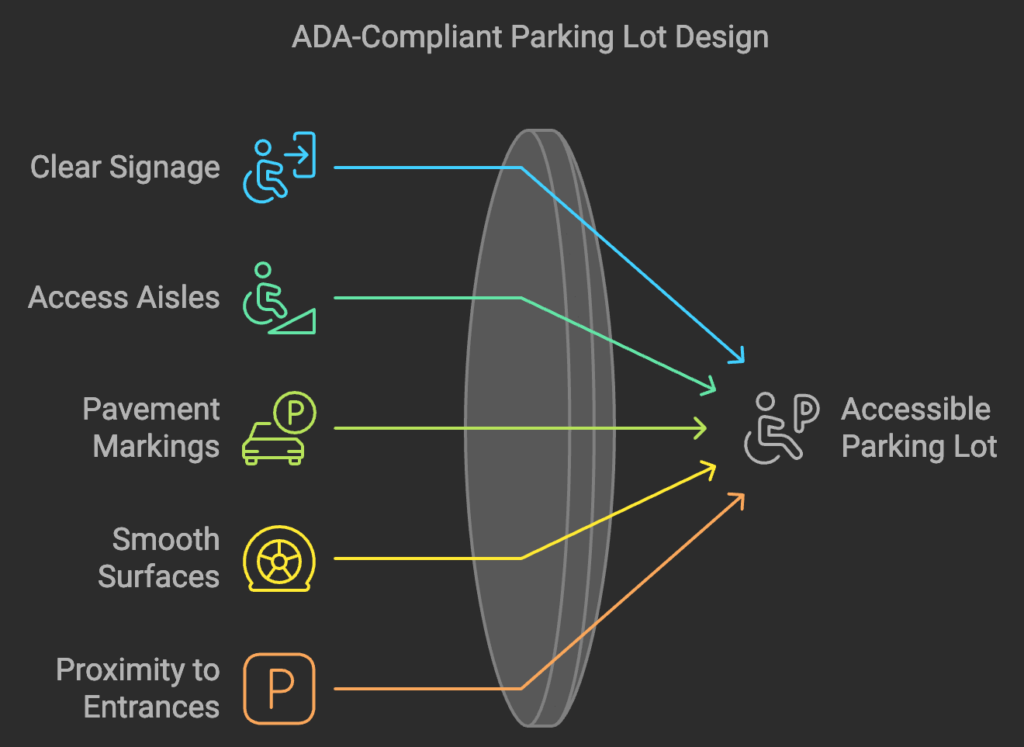Creating an accessible environment for everyone, including individuals with disabilities, is not just a best practice—it’s a legal requirement under the Americans with Disabilities Act (ADA). For property owners and managers, understanding what the ADA means in a parking lot is crucial for designing or updating your facilities to be inclusive and compliant.
In Green Bay and across the nation, ensuring your parking lot adheres to ADA standards means providing accessible, welcoming spaces that allow individuals with mobility challenges to easily navigate your property.
What Does It Take to Be ADA Compliant?
What does it take to be ADA compliant? It requires careful planning and adherence to specific guidelines established by the ADA. These guidelines dictate everything from the number of accessible spaces to their size, slope, signage, and connectivity to accessible routes. The goal is to remove barriers and ensure equal access for all.
What Makes a Parking Lot ADA Compliant? Key Requirements
What makes a park ADA compliant? While the term “park” might imply a recreational area, the principles of ADA compliance for parking apply broadly to any parking facility serving a public accommodation or commercial facility. Here are the core components:
- Number of Accessible Spaces:
- The ADA Standards for Accessible Design (2010 ADA Standards) specify a minimum number of accessible parking spaces based on your lot’s total capacity. This calculation is done per parking facility, not site-wide.
- For example:
- 1 to 25 total spaces: 1 accessible space
- 26 to 50 spaces: 2 accessible spaces
- 51 to 75 spaces: 3 accessible spaces
- … and so on. For lots with over 1000 spaces, 20 spaces are required, plus 1 for each additional 100 spaces or fraction thereof.
- A critical detail: At least one of every six accessible spaces must be designated as van-accessible. If your lot only requires one accessible space, it must be van-accessible.
- Types and Dimensions of Accessible Spaces:
- Standard Accessible Spaces: These must be at least 96 inches (8 feet) wide. They require an adjacent access aisle at least 60 inches (5 feet) wide.
- Van-Accessible Spaces: To accommodate wheelchair lifts and larger mobility devices, these spaces need to be larger. They can be:
- 132 inches (11 feet) wide with a 60-inch (5-foot) access aisle, OR
- 96 inches (8 feet) wide with a 96-inch (8-foot) access aisle.
- Access aisles must extend the full length of the parking space and be marked to prevent parking in them. They can be shared between two accessible spaces (except in angled parking, where it must be on the passenger side).
- Van-accessible spaces and access aisles also require a minimum vertical clearance of 98 inches (8 feet 2 inches).
- Slope Tolerance and Surface Requirements:
- Both accessible parking spaces and their access aisles must have a slope no greater than 1:48 (2.08%) in all directions. This strict requirement ensures that individuals using mobility devices can enter and exit vehicles and navigate the space safely without encountering excessive inclines or declines.
- Surfaces must be firm, stable, and slip-resistant, free from cracks, potholes, or uneven areas that could pose hazards.
- Strategic Location:
- Accessible parking spaces must be located on the shortest accessible route to the accessible building entrance. This may not always be the physically closest spot, but rather the path offering the easiest, unobstructed access.
- If a facility has multiple accessible entrances, accessible parking spaces should be dispersed among them.
- Clear Signage:
- Each accessible space must display the International Symbol of Accessibility.
- Van-accessible spaces require additional “Van Accessible” signage below the International Symbol.
- Signs should be mounted at least 60 inches (5 feet) above the ground (measured to the bottom of the sign) to ensure visibility.
- While not federally mandated, many states and municipalities require the International Symbol of Accessibility to be painted within the parking space.
- Accessible Routes and Curb Ramps:
- Access aisles must connect directly to an accessible route (sidewalk or pathway) leading to the building entrance.
- If there’s a curb, a curb ramp is essential to provide a smooth transition for wheelchair users and others with mobility aids. These ramps must also meet specific slope and dimension requirements.
What Are the Exceptions to ADA Parking Requirements?
While ADA compliance is broad, there are a few limited exceptions:
- Small Parking Lots: One van-accessible space must be provided for parking facilities with four or fewer total parking spaces, but a sign identifying the accessible space is not required.
- Designated Vehicle Parking: Parking spaces exclusively used for vehicles like buses, trucks, or law enforcement vehicles are generally exempt. However, if the public has access for loading/unloading, accessible loading zones may be required.
- Assigned Residential Parking: In residential facilities where parking spaces are assigned to specific residences, identification of accessible spaces is not required.
- Specific Medical Facilities: While generally requiring more accessible parking, specific percentages apply. For example, hospital outpatient facilities need 10% of patient/visitor parking to be accessible, and rehabilitation or outpatient physical therapy facilities require 20%.
It’s crucial to remember that state and local building codes may have requirements above and beyond federal ADA standards. Always check with your local authorities to ensure full compliance.
Steps to Upgrade Your Parking Lot for ADA Compliance
Ensuring your parking lot is compliant is a multi-step process that often requires professional expertise:
- Conduct a Thorough Assessment: Review your existing parking lot to identify areas that do not meet current ADA standards, including the number of spaces, dimensions, slopes, signage, and accessible routes.
- Plan for Design & Layout Changes: Based on the assessment, plan for necessary modifications to space allocation, striping, and the creation or modification of access aisles and accessible routes.
- Verify Slope and Surface Requirements: Measure slopes precisely and consider resurfacing or repaving if the current surface is uneven, cracked, or exceeds the 1:48 slope tolerance.
- Update Signage and Markings: Ensure all accessible spaces have the correct International Symbol of Accessibility and “Van Accessible” signs mounted at the proper height. Restripe the lot with clear, contrasting markings for spaces and access aisles.
- Ensure Accessible Routes: Confirm that all parking spaces connect to accessible building entrances via a firm, stable, slip-resistant, and barrier-free route, including compliant curb ramps where necessary.
- Work with a Qualified Professional: ADA compliance involves precise specifications and understanding federal and local regulations. Partnering with experienced pavement contractors like American Pavement Solutions ensures your project meets all standards, preventing costly errors, fines, or potential lawsuits.
By understanding what makes a parking lot ADA compliant and partnering with experts, you can create an accessible, safe, and welcoming environment for all visitors to your Green Bay property.
Contact American Pavement Solutions today for a free estimate to assess your parking lot and ensure it meets all ADA compliance requirements.



